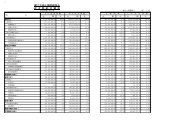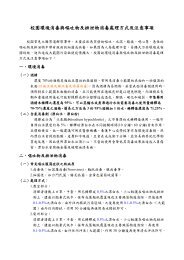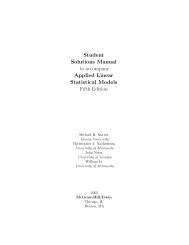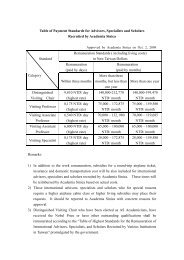Journal of Film Preservation - FIAF
Journal of Film Preservation - FIAF
Journal of Film Preservation - FIAF
You also want an ePaper? Increase the reach of your titles
YUMPU automatically turns print PDFs into web optimized ePapers that Google loves.
Helsinki, ikuisesti / Helsinki, Forever<br />
(Peter von Bagh, Finlande 2008) est fort<br />
différent des deux films précédents.<br />
Pourtant, comme Bourdon et Davies,<br />
von Bagh nous parle de changements,<br />
mais le commentaire attache plus<br />
d’importance au matériel d’archives<br />
en tant que tel. De plus, von Bagh<br />
ne se limite pas à utiliser du matériel<br />
d’archives; il utilise des séquences de<br />
films de fiction tournés à Helsinki et<br />
des tableaux (qui datent parfois d’avant<br />
l’arrivée du cinéma) qui apportent<br />
un élément de couleur manquant<br />
aux archives en noir et blanc. Comme<br />
chez Davies, le commentaire est fait<br />
d’emprunts multiples et de la musique<br />
des films de fiction cités, mais ce<br />
sont les réflexions de von Bagh sur le<br />
matériel d’archives et sur la fiction qui<br />
constituent l’élément le plus original<br />
de ce commentaire, notamment les<br />
passages sur la relation entre le présent<br />
et le passé.<br />
Le film de Peter von Bagh est un film<br />
sur Helsinki, bien sûr, mais c’est aussi un<br />
film sur la magie des vieilles images. Et<br />
l’époustouflante séquence d’ouverture<br />
(un cargo fendant les glaces du port<br />
d’Helsinki au milieu des badauds euxmêmes<br />
sur la glace) en constitue déjà<br />
la démonstration, comme le fera aussi<br />
magnifiquement la séquence qui clôt<br />
le film (le retour des troupes) et qui<br />
permet à von Bagh de terminer sa<br />
réflexion par ces mots : « L’histoire nous<br />
regarde ».<br />
Le dernier des « city films » ici recensés<br />
est d’un mode fort différent. The<br />
London Nobody Knows (Norman<br />
Cohen, UK 1967) s’appuie sur un livre<br />
de Ge<strong>of</strong>frey Fletcher qui proposait de<br />
visiter des lieux de Londres disparus et<br />
oubliés, si ce n’est par leurs habitants. Il<br />
s’agit ici de filmer des lieux à la veille de<br />
disparaître : ainsi en est-il d’un théâtre<br />
du quartier de Bedford, finalement rasé<br />
deux ans après le tournage du film.<br />
Autre élément particulier : le film utilise<br />
un « guide » : James Mason, casquette<br />
plate et veste de tweed, nous promène<br />
en ces lieux de façon tout à fait<br />
convaincante. Enfin le commentaire,<br />
parfois ironique, insiste sur le fait que<br />
ce Londres-là, même en partie démoli,<br />
a encore une vraie vie de quartier.<br />
P.S. Comme le signale l’auteur dans<br />
ses paragraphes de conclusion, le<br />
visionnement (et la projection sur<br />
grand écran) de ces films, tous d’une<br />
the heart <strong>of</strong> the city and the film cuts to the downtown as night falls.<br />
Frequently, it is people that provide the cutting points: a look, a gesture.<br />
The film ends in silence as an old man walks down a tunnel arch under<br />
some buildings and out <strong>of</strong> sight. The old must give way to the new. But<br />
there is a coda, in some ways strange, with the credits <strong>of</strong> the film, scenes<br />
from Expo 67. This hugely successful world exposition comes full circle<br />
from the beginning <strong>of</strong> the film, where Montréal is seen as the gateway to<br />
Canada. Here in 1967 Montréal is a gateway for Canada to welcome the<br />
peoples <strong>of</strong> the world. Expo is remembered with affection and pride across<br />
Canada – a moment when Canadians seemed to come together as a nation,<br />
filled with hope for the future. An irony, if one remembers the nationalist<br />
emotions on fire in Québec in 1967. For others, like myself, a sadness. The<br />
hope in that glowing colour footage seems diminished in Canada today.<br />
I first saw La Mémoire with a Montréal audience. The result was electric, an<br />
audience moved to a pr<strong>of</strong>ound silence. There has been debate as to how<br />
well the film will travel. We are not told the location, nor is there any setup<br />
for, say, a viewer in Germany. I myself wonder if there should be a brief<br />
introduction, a text on the screen. I have now seen the film several times,<br />
and accept what must be Bourdon’s position – that there is a humanity and<br />
experience common to all <strong>of</strong> us who live in Western urban environments.<br />
That commonality will deliver itself to all viewers who open themselves to<br />
this extraordinary film.<br />
La Mémoire comes in two forms, an original French version and a subtitled<br />
English version. Rather cleverly, one can play the French version or the<br />
English one on the DVD, rather than hunting for the language option.<br />
In other words, not as is the usual practice, is there an original version<br />
with optional subtitles. One can switch to the extras in the same manner.<br />
The main extra is a shortish interview with the director and editor. For<br />
the English version one is presented with a different interview with the<br />
same people but in English, not subtitled. Unfortunately, and perhaps<br />
unsurprisingly, the English interviews are not as informative as the French,<br />
which give more insight into the process and the philosophy underlying<br />
the film. The end result is bit unsatisfying. There is a way in which extras<br />
have now become a bind for producers and distributors. Companies like<br />
Criterion and big studios (e.g., Warner Brothers) have raised the ante, and<br />
the public now expects more than a brief interview; and this is a problem,<br />
since extras cost money to make! There are, however, two very useful film<br />
extras with La Mémoire, Inland Port and Parc Lafontaine. Footage from both<br />
figures strongly in the film and one gets a first notion <strong>of</strong> Bourdon’s editing<br />
process. This heightens my feelings that a whole richness <strong>of</strong> possibilities<br />
has been missed in the extras accompanying the film. Strangely enough,<br />
perhaps intentionally, Inland Port sets up La Mémoire for non-Montréal<br />
audiences admirably.<br />
There is no printed documentation with the film. This is a pity. Luc Bourdon<br />
has been interviewed in print. There is a very enlightening interview with<br />
him in the Canadian film journal 24 Images. I mention this because there is<br />
a good booklet with Of Time and the City. The extras with Of Time and the<br />
City are perfectly satisfactory. There is a process documentary with the two<br />
producers, Roy Boulter and Solon Papadopolous, the archive researcher,<br />
Jim Anderson, and Davies himself. This is enlightening, as is an edited Q<br />
& A with Davies from a screening <strong>of</strong> the film. I did wonder if there was<br />
59 <strong>Journal</strong> <strong>of</strong> <strong>Film</strong> <strong>Preservation</strong> / 81 / 2009
















